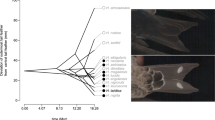Abstract
The feeding apparatus of Paleogene birds is rarely well-preserved. Here, we describe the earliest known pelican (early Oligocene, Luberon, southeastern France), with its almost complete beak. Morphologically identical to modern pelicans, the new fossil already shows several advanced features unique to extant species of the genus Pelecanus. It probably belongs to the lineage ancestral to all or some of these pelican species. This fossil reveals a remarkable evolutionary stasis in the morphology of such an advanced avian feeding apparatus through ca. 30 million years. Several hypotheses are proposed to suggest explanations for such examples of long stases in volant homeothermic vertebrates.

Similar content being viewed by others
Abbreviations
- LAC:
-
Laboratoire d’Anatomie Comparée, Muséum National d’Histoire Naturelle de Paris, France
- MVZ:
-
Museum of Vertebrate Zoology, Berkeley, USA
- UCBL:
-
Université Claude Bernard Lyon 1, Villeurbanne, France
References
Baumel JJ, Witmer LM (1993) Osteologia. In: Baumel JJ, King AS, Breazile JE, Evans HE, Vanden Berge JC (eds) Handbook of avian anatomy: nomina anatomica avium, 23. Publ Nuttall Ornithol Club, Cambridge, pp 45–132
BirdLife International (2004) Threatened birds of the world 2004. CD-ROM BirdLife International, Cambridge
Björklund M (1994) Processes generating macroevolutionary patterns of morphological variation in birds: a simulation study. J Evol Biol 7:727–742
Cavelier C (1984) Paléogène. Mém BRGM France 125:389–468
Cheneval J (1984) Les oiseaux aquatiques (Gaviiformes à Ansériformes) du gisement aquitanien de Saint-Gérand-le Puy (Allier, France): révision systématique. Palaeovertebrata 14:33–115
Elliott A (1992) Pelecanidae. In: Del Hoyo J, Elliott A, Sargatal J (eds) Handbook of the birds of the world, 1. Ostrich to ducks. Lynx Edicions, Barcelona, pp 290–311
Ericson PGP, Anderson CL, Britton T, Elzanowski A, Johansson US, Källersjö M, Ohlson JI, Parsons TJ, Zuccon D, Mayr G (2006) Diversification of Neoaves: integration of molecular sequence data and fossils. Biol Lett 2:543–547
Escarguel G, Marandat B, Legendre S (1997) On the numerical ages of the Paleogene mammalian faunas from Western Europe, particularly of the lower and middle Eocene. Mém Trav EPHE Inst Montpellier 21:443–460
Gavrilets S (1997) Evolution and speciation on holey adaptive landscapes. Trends Ecol Evol 12:307–312
Hackett SJ, Kimball RT, Reddy S, Bowie RCK, Braun EL, Braun MJ, Chojnowski JL, Cox WA, Han KL, Harshman J, Huddleston CJ, Marks BD, Miglia KJ, Moore WS, Sheldon FH, Steadman DW, Witt CC, Yuri T (2008) A phylogenomic study of birds reveals their evolutionary history. Science 320:1763–1768
Heizmann EPJ, Hesse A (1995) Die mittelmiozänen Vogel- und Säugetierreste des Nördlinger Ries (MN 6) und des Steinheimer Beckens (MN 7)–ein Vergleich. Cour Forschungsinst Senckenb 181:171–185
James HF, Olson SL (1991) Description of thirty-two new species of birds from the Hawaiian Islands: Part II. Passeriformes. Ornithol Monogr 46:3–88
López-Martínez N (1997) Lignées évolutives, formes intermédiaires et évolution en mosaïque: exemple des lagomorphes Européens. Mém Trav EPHE Inst Montpellier 21:105–120
Louchart A (2008) Fossil birds of the Kibish formation. J Human Evol 55:513–520
Louchart A, Tourment N, Carrier J, Roux T, Mourer-Chauviré C (2008) Hummingbird with modern feathering: an exceptionally well-preserved Oligocene fossil from southern France. Naturwiss 95:171–175
Maître E (2008) Les Chiroptères paléokarstiques d’Europe occidentale, de l’Eocène moyen à l’Oligocène inférieur, d’après les nouveaux matériaux du Quercy (SW France): Systématique, phylogénie, paléobiologie. Dissertation, Université Claude Bernard Lyon 1, Villeurbanne, France
Meyers RA, Myers RP (2005) Mandibular bowing and mineralization in brown pelicans. Condor 107:445–449
Schmidt-Kittler N, Vianey-Liaud M, Mödden C, Comte B (1997) New data for the correlation of mammal localities in the European Oligocene: biochronological relevance of the Theridomyidae. Mém Trav EPHE Inst Montpellier 21:375–395
Sigé B, Hugueney M (2006) Les micromammifères des gisements à phosphate du Quercy (SW France). Strata Sér I 13:207–226
Tyrberg T (2002) Avian species turnover and species longevity in the Pleistocene of the Palearctic. In: Zhou Z, Zhang F (eds) Fifth symposium of the society of avian paleontology and evolution, Beijing, 2000. Science Press, Beijing, pp 281–289
Wright S (1932) The roles of mutations, inbreeding, crossbreeding and selection in evolution. In: Proceedings of the Sixth International Congress of Genetics, vol 1, pp 356–366
Zink RM (2002) A new perspective on the evolutionary history of Darwin’s finches. Auk 119:864–871
Zusi RL, Warheit KI (1992) On the evolution of intraramal mandibular joints in pseudodontorns (Aves: Odontopterygia). Nat Hist Mus Los Angel Cty Sci Ser 36:351–360
Acknowledgments
We thank C. Lefèvre and C. Mourer-Chauviré for access to modern specimens, D. Berthet for access to Miopelecanus specimens, A. Prieur for making the cast, L. Costeur, E. Maître, B. Sigé, and R. A. Meyers for thoughtful discussion on diverse aspects, L. Viriot and S. L. Olson for comments on earlier drafts, and two anonymous referees for comments which improved the manuscript.
Conflict of interest statement
The authors declare that they have no conflict of interest.
Author information
Authors and Affiliations
Corresponding author
Additional information
Communicated by F. Bairlein.
Rights and permissions
About this article
Cite this article
Louchart, A., Tourment, N. & Carrier, J. The earliest known pelican reveals 30 million years of evolutionary stasis in beak morphology. J Ornithol 152, 15–20 (2011). https://doi.org/10.1007/s10336-010-0537-5
Received:
Revised:
Accepted:
Published:
Issue Date:
DOI: https://doi.org/10.1007/s10336-010-0537-5




